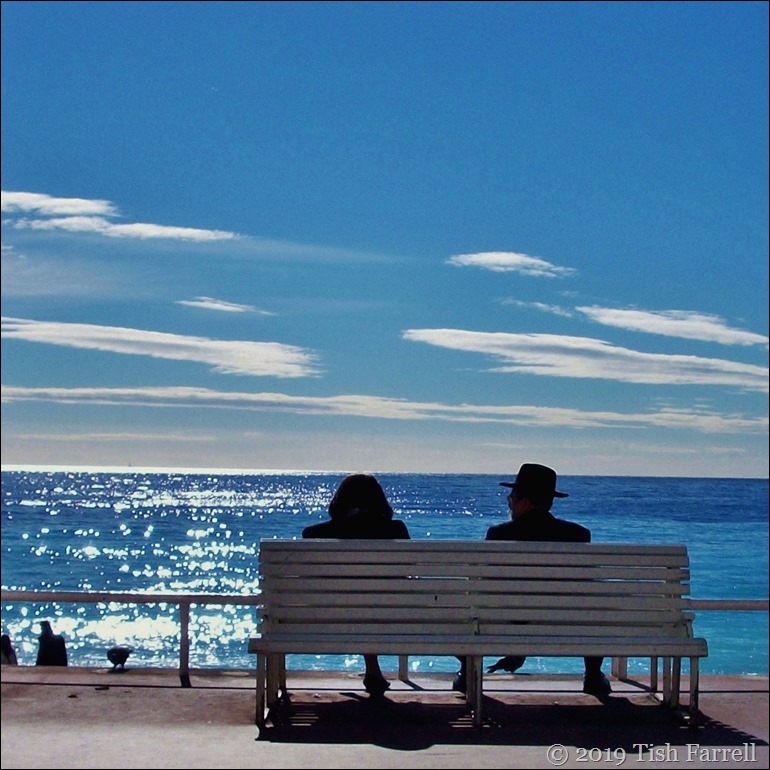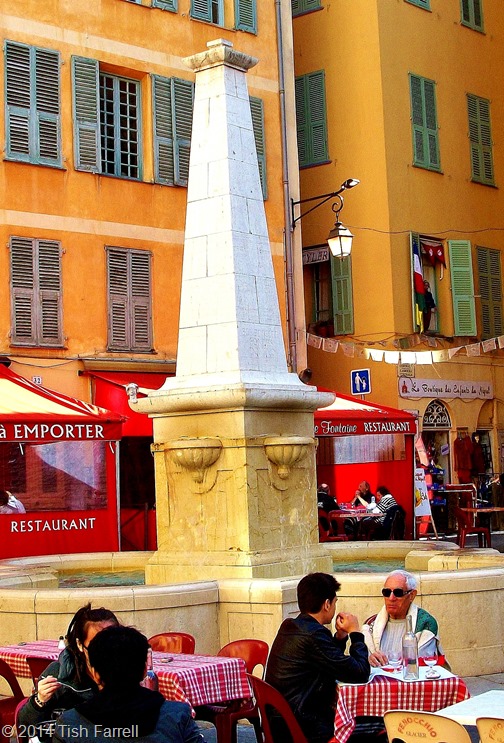“…there is less rain and wind at Nice, than in any other part of the world that I know; and such is the serenity of the air, that you see nothing above your head for several months together, but a charming blue expanse, without cloud or speck.”
Tobias Smollett Travels Through France And Italy 1764
*

Umbrellas beside the Promenade des Anglais, round-topped palms and the cupola of the Hotel Negresco against a china blue sky. Where else but Nice.
*
Nice is pretty much a year-round travel destination, a fact first discovered in 1731 by members of the English aristocracy. Lord and Lady Cavendish were the trendsetters in question, and from the time of their visit onwards, anyone who was anyone began to spend the winter season there. By 1860 there were 704 foreign families wintering in this way. Of these, 252 were English, and 128 were Russian. There were lesser numbers of well-heeled Germans and Americans. The arrival of the railway in 1864 further helped to boost upper class tourism, making it possible to leave London Bridge Station at 7.40 on a Monday morning, and reach Nice by Tuesday suppertime.
The benign climate and shiny bright days also made it popular with convalescents, the “pale and listless English women and listless sons of nobility near death” as French historian Paul Gonnet described them. Very soon then, and in response to this influx of moneyed people, Nice the fishing port transformed itself into Nice the fashionable resort for Europe’s elite.
Among that elite was an elderly Queen Victoria. She travelled under the name Lady Balmoral, although heaven knows why. There could have been no failing to notice her arrival, coming as she did in her own train, accompanied with up to a hundred staff, and her Scottish pipers piping her in. Full warning of her advent was further marked by the forward arrival of her bed. In 1895 and 1896 she spent her spring sojourn in The Grand Hotel, Cimiez just outside Nice. But for the next three years she and all her royal household would occupy, through March and April, the entire west wing of the Hotel Excelsior Regina Palace. This was a brand new hotel, built with the Queen specifically in mind, it being well recognized that Lady Balmoral’s continued patronage of Nice did much to boost local business and encourage tourism. By the end of the 19th century the city’s population reputedly increased by 80,000 during the winter months.

One wing of the vast Hotel Excelsior Regina Palace, now apartments.
*
One of the things that most people know about Queen Victoria is that she was tiresomely dreary for years after Prince Albert’s death. When in Nice, though, she underwent a complete transformation, girlishly taking part in local festivities, driving around in a donkey cart that allowed her to explore byways too narrow for her carriage, inviting the scarcely respectable Sarah Bernhardt to put on a private performance, handing out presents to all and sundry. In fact she brought with her to France a trunk filled with watches and chains, pens, inkstands, portraits and cigarette holders. These she bestowed on all ranks – from hotel staff upwards, while keeping account of who had received what so she would not give anyone the same thing twice. On her death bed she famously said, “If only I were at Nice, I would recover.”

In the 20th century, the Cote d’ Azur became the haunt of the avant-garde: Matisse, Picasso, Stravinsky, Diaghilev, Ernest Hemingway, Henry Miller, Gertrude Stein, Chagall. In later life Matisse had a studio in the The Hotel Excelsior. But for travellers and tourists, the hotel to stay in was, and still is for that matter, Le Negresco.
It was built by Henri Negrescu (later Negresco), son of a Romanian innkeeper, and opened for business in 1913. In the first year the hotel made a profit of 800,000 francs in gold, but then came war, and Negresco turned the place into a hospital. He died, penniless, a few years later. His hotel, though, goes from strength to strength. Its past guests include Louis Armstrong, Salvador Dali, Princess Grace of Monaco, Queen Elizabeth II, Duke and Duchess of Windsor, the Beatles, Ava Gardner, James Dean, Frank Sinatra, Edith Piaf, and Michael Jackson.
When we visited Nice a few years ago we saw no one famous in the bar or foyer. In fact it was all rather quiet. We decided to have dinner in the hotel’s very bizarre brasserie, La Rotonde. As you can see, it’s an inside-out carousel in overdone pink.


La Rotonde brasserie, Hotel Negresco
*
Every hour, parts of the decor come to life, fairground style, while a life-size figure of a girl in an ill-fitting smock and straw hat rotates in the centre of the dining room. We found it all rather perplexing, and the food was not good enough to distract us from feeling we were in the wrong place. In fact there were much nicer things to eat, or at least look at along the streets of Vieux Nice. And as it happens, most of them were round.







Easter Greetings Everyone
AILSA’S TRAVEL CHALLENGE: ROUND
A Word A Week Challenge: Round for more round posts
Nancy Merrill Photography
Snap Thoughts
It’s not what you look at that matters
Reference:
Michael Nelson 2007 Queen Victoria and the Discovery of the Riviera
© 2014 Tish Farrell




































